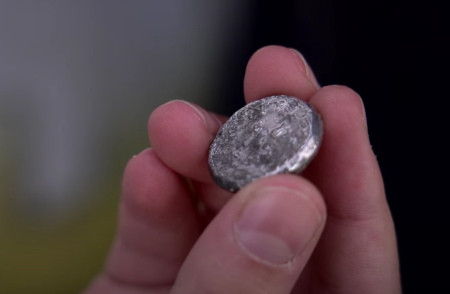11-year-old girl finds rare ‘Holy Jerusalem’ coin minted during Great Revolt against Rome

An 11-year-old girl in Israel found a rare silver coin from the first century, with the inscription “Holy Jerusalem,” while volunteering for an archaeological project, Israel Antiquities Authority has announced.
The girl, Liel Krutokop, was volunteering with her family at the Emek Tzurim National Park in Jerusalem when she discovered the 14-gram silver coin. The Jerusalem Post reported that archaeologists believe the coin was minted by a priest who joined the Jewish rebels against the Romans.
“This is a rare find,” Robert Krool, who leads the IAA’s Coin Department, was quoted as saying. “[O]ut of many thousands of coins discovered to date in archaeological excavations, only about 30 are coins made of silver from the period of the Great Revolt.”’
The Great Revolt refers to the First Jewish-Roman War that lasted from 66 A.D. until 75 A.D.
On one side, the coin features a cup and the inscription “Israeli shekel” and “second year,” referring to the second year of the revolt (67-68 CE). The newspaper notes the other side carries the inscription “Holy Jerusalem” in ancient Hebrew script, a word supposedly referring to the headquarters of the High Priest in the Temple.
“I thought there must be simple coins in the buckets, but I did not think I would find a coin myself, and certainly not such a rare coin from pure silver,” the girl was quoted as saying in a statement.
“We poured the bucket with the dirt on the strainer, and as we filtered the stones that were inside, I saw something round,” Krutokop said, as translated by the Jewish Telegraphic Agency.
“At first, I did not know what it was, but it looked different from all the other stones…I was very excited.”
Kool stated that the currency is a “sign of sovereignty.”
“If you go into rebellion, you use one of the most obvious symbols of independence, and you mint coins,” Kool detailed. “The inscription on the coin clearly expresses the rebels’ aspirations. The choice to use ancient Hebrew script, which was no longer in use at the time, is not accidental. The use of this script came to express the longing of the people of the period for the days of David and Solomon and the days of a united Jewish kingdom — days when the people of Israel had full independence in the land.”
Archaeologist Ari Levy said in a statement that the street where the coin was excavated was Jerusalem’s “main street” during the Second Temple period and would have been used by thousands of pilgrims as they went to the temple.
“There is no doubt that there would have been extensive trading here,” Levy said, according to The Times of Israel. “This is evidenced by the many weights and bronze coins we have found here. But to find a rebel coin made of pure silver is definitely very special and exciting.”





















